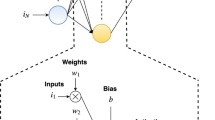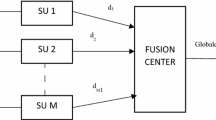Abstract
Resource allocation is most needed in the next generation of Cognitive radio networks these techniques are used to increase the Cognitive radio network’s performance. But, it is difficult to accomplish these techniques in real-time performance wireless. In this paper, a resource allocation technique based on artificial neural networks (ANN) is proposed which helps to reduce the power consumption in the network. The goal of the proposed scheme is to secure data transmission and to increase the uplink and downlink speed with less bit error rate. From the Simulation results, it can be observed that the proposed technique based on ANN is efficient in terms of the computation time related to the other resource allocation techniques. To increase the security of the data transmission in networks Location-based key management system is used. This paper is implemented by NS2.









Similar content being viewed by others
References
Kong, F., Cho, J., & Lee, B. (2017). Optimizing spectrum sensing time with adapitive sensing interval for energy- efficient CRSNs. IEEE Sensors Journal, 17(22), 7578–7588.
Almasaeid, H. M, Jawadwala, T. H., & Kamal, A. E. (2010). On-demand multicast routing in cognitive radio mesh networks. In Proceedings of IEEE Global Telecommunications Conference, pp. 1–5.
Askari, M, Kavian, Y. S, Kaabi, H., Rashvand, H. F. (2012). A channel assignment algorithm for cognitive radio wireless sensor networks. In Proceedings of Wireless Sensor System (WSS), p. 12.
Atapattu, S., Tellambura, C., & Jiang, H. (2010). Analysis of area under the ROC curve of energy detection. IEEE Transactions on Wireless Communications, 9(3), 1216–1225.
Awin, F., Abdel Raheem, E., & Ahmadi, M. (2017). Joint optimal transmission power and sensing time for energy efficient spectrum sensing in cognitive radio system. IEEE Sensors Journals, 17(2), 369–376.
de Souza Lima Moreira, G., & de Souza, R. A. A. (2016). On the throughput of cognitive radio networks using eigenvalue-based cooperative spectrum sensing under complex Nakagami-m fading. In Proceedings International Symposium on Networks, Computers and Communications (ISNCC), pp. 1–6.
Deepak, G. C., & Navaie, K. (2013). On the sensing time and achievable throughput in sensor-enabled cognitive radio networks. In Proceedings of Wireless Communications Systems (ISWCS), pp. 1–5.
Ewaisha, A., Sultan, A., & ElBatt, T. (2011). Optimization of channel sensing time and order for cognitive radios. In Proceedings of Wireless Communications Network Conference (WCNC), pp. 1414–1419.
Fu, J., Yibing, Z., Yi, L., Shuo, L., & Jun, P. (2015). The energy efficiency optimization based on dynamic spectrum sensing and nodes scheduling in cognitive radio sensor networks. In Proceedings Control Decision Conference (CCDC), pp. 4371–4378.
He, H., Li, G. Y., & Li, S. (2013). Adaptive spectrum sensing for time-varying channels in cognitive radios. IEEE Wireless Communications Letter, 2(2), 1–4.
Lu, L., Li, G. Y., Swindlehurst, A. L., Ashikhmin, A., & Zhang, R. (2014). An overview of massive MIMO: Benefits and challenges. IEEE Journal of Selected Topics Signal Process., 8(5), 742–758.
Bjornson, E., Larsson, E., & Debbah, M. (2016). Massive MIMO for maximal spectral efficiency: How many users and pilots should be allocated? IEEE Transactions on Wireless Communications, 15(2), 1293–1308.
Ho, W. W. L., & Liang, Y.-C. (2009). Optimal resource allocation for multiuser MIMO-OFDM systems with user rate constraints. IEEE Transactions on Vehicular Technology, 58(3), 1190–1203.
Jose, J., Ashikhmin, A., Marzetta, T., & Vishwanath, S. (2011). Pilot contamination and precoding in multi-cell TDD systems. IEEE Transactions on Communications, 10(8), 2640–2651.
Marzetta, T. (2010). Noncooperative cellular wireless with unlimited numbers of base station antennas. IEEE Transactions on Wireless Communications, 9(11), 3590–3600.
Dai, L., Gao, X., Su, X., Han, S., & Wang, Z. (2015). Low-complexity soft-output signal detection based on Gauss-Seidel method for uplink multi-user large-scale MIMO systems. IEEE Transactions on Vehicular Technology, 64(10), 4839–4845.
Tachwali, Y., Lo, B. F., Akyildiz, I. F., & Agusti, R. (2013). Multiuser resource allocation optimization using bandwidth-power product in cognitive radio networks. IEEE Journal on Selected Areas in Communications, 31(3), 451–463.
Hao, W., Yang, S., Muta, O., Gacanin, H., & Furukawa, H. (2016). Energye_cient resource allocation in sensing-based spectrum sharing for cooperative cognitive radio networks. IEICE Transactions on Communications, 99(8), 1763–1771.
Ahmad, A., Ahmad, S., Rehmani, M. H., & Hassan, N. U. (2015). A survey on radio resource allocation in cognitive radio sensor networks. IEEE Commun. Surveys and Tutorials, 17(2), 888–917.
Almalfouh, S. M., & Stuber, G. L. (2011). Interference-aware radio resource allocation in OFDMA-based cognitive radio networks. IEEE Transactions on Vehicular Technology, 60(4), 1699–1713.
Hao, W., Yang, S., Ning, B., & Hao, W. (2015). Optimal resource allocation for cooperative orthogonal frequency division multiplexing-based cognitive radio networks with imperfect spectrum sensing. IET Communications, 9(4), 548–557.
Dhanjal, S. (2001). Artificial neural networks in speech processing: problems and challenges. In IEEE Pacific Rim Conference on Communications, Computers and Signal Processing, vol. 2, pp. 510–513
Giribone, P., Revetria, R., Antonetti, M., & Tabolacci, R. (2000) Use of artificial neural networks as support for energy saving procedures in telecommunications. Telecomm Energy Conf., INTELEC. pp. 159–162
Haykin, S. (1999). Neural networks: A comprehensive foundation. New Jersey: Prentice-Hall.
Andra, P. (2005). A neural activity pattern systems. In Proceedings of Neuro Computing vol. 65–66, pp. 531–536, Elsevier.
Tumuluru, V. K., Wang, P., & Niyato, D. (2010). A neural network based spectrum prediction scheme for cognitive radio. In IEEE International Conference ICC, pp. 1–5.
Wang, L., Ngo, H. Q., Elkashlan, M., Duong, T. Q., & Wong, K. (2017). Massive MIMO in spectrum sharing networks: Achievable rate and power efficiency. IEEE Systems Journal, 11(1), 20–31.
Filippou, M., Gesbert, D., & Yin, H. (2012). Decontaminating pilots in cognitive massive MIMO networks. In Proceedings of the International Symposium on Wireless Communication Systems, pp. 816–820.
Xie, H., Wang, B., Gao, F., & Jin, S. (2016). A full-space spectrum-sharing strategy for massive MIMO cognitive radio systems. IEEE Journal on Selected Areas in Communications, 34(10), 2537–2549.
Cladia, A. T., Rajavel, S. E. (2018). Optimizing spectrum sensing for energy efficient cognitive radio sensor networks. In International Conference on Smart Systems and Inventive Technology (ICSSIT 2018), IEEE Xplore Part Number: CFP18P17-ART; ISBN:978–1–5386–5873–4.
Author information
Authors and Affiliations
Corresponding author
Additional information
Publisher's Note
Springer Nature remains neutral with regard to jurisdictional claims in published maps and institutional affiliations.
Rights and permissions
About this article
Cite this article
Rajavel, S.E., Aruna, T., Rajakumar, G. et al. Optimizing Spectrum Sensing by Using Artificial Neural Network in Cognitive Radio Sensor Networks. Wireless Pers Commun 125, 803–817 (2022). https://doi.org/10.1007/s11277-022-09578-1
Accepted:
Published:
Issue Date:
DOI: https://doi.org/10.1007/s11277-022-09578-1




